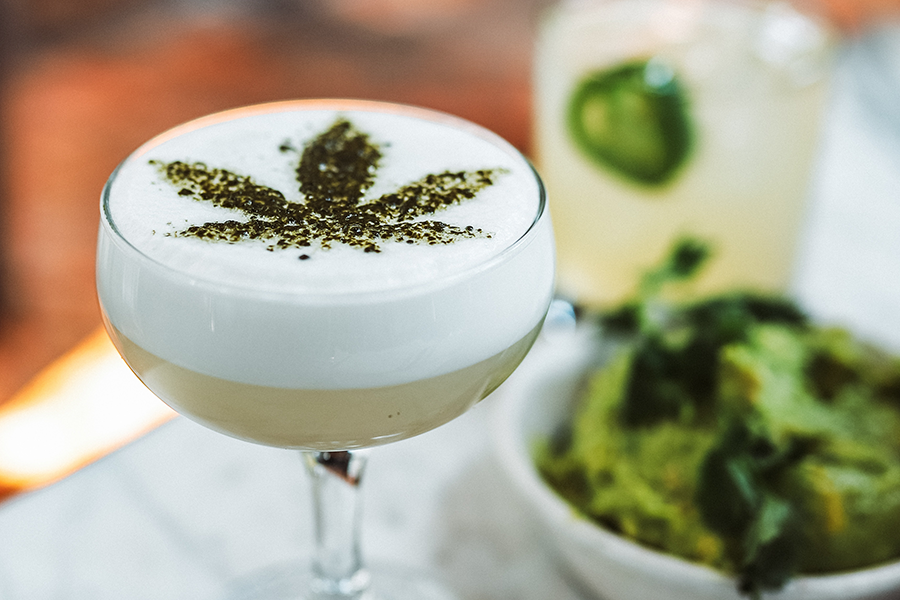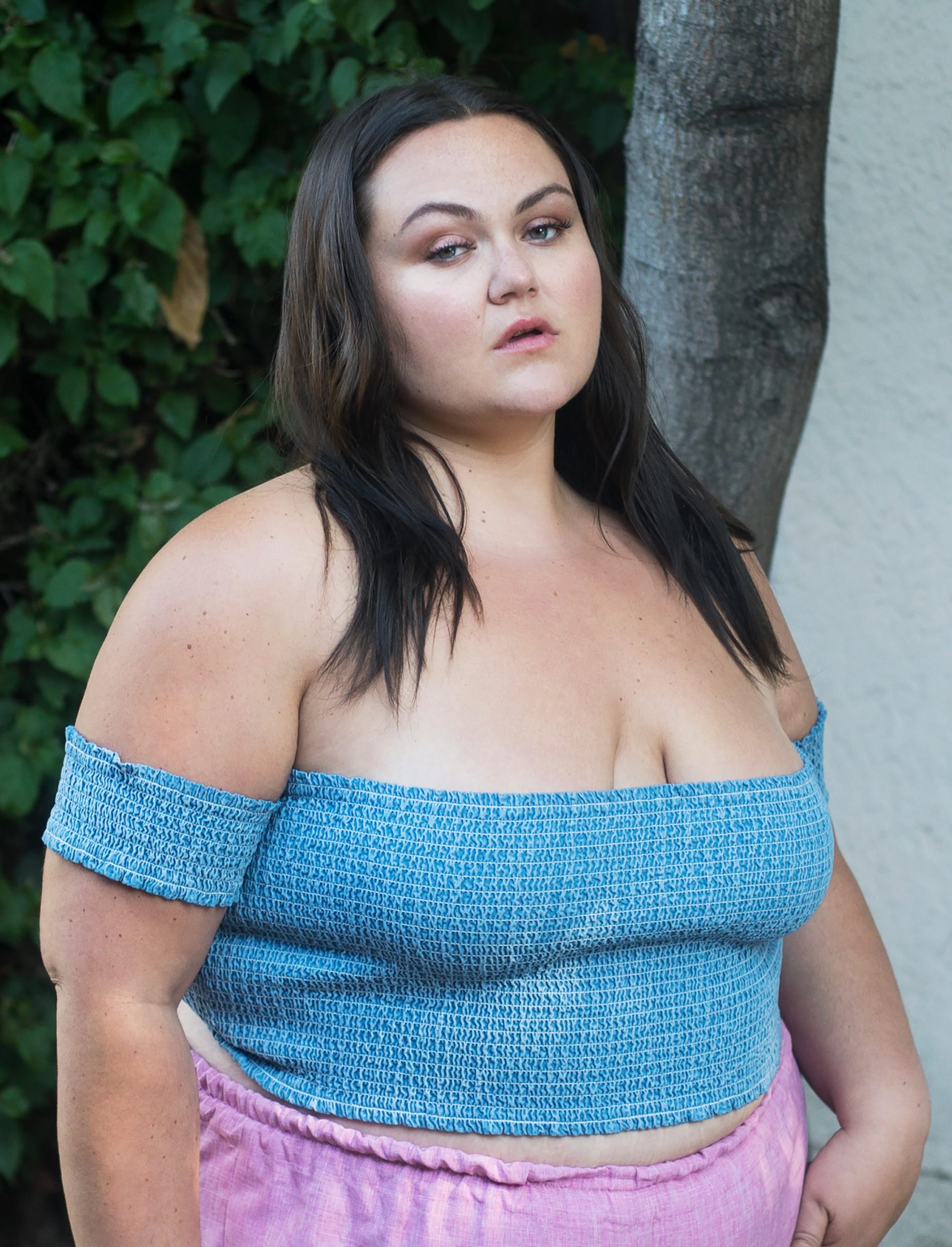Ross Hunsinger, the director of food and beverage innovation at True Terpenes, describes himself as a “high-level beverage guy.” He’s a longtime brewer and creator of avant-garde cocktails, with a history of running conceptual bar programs at super-fancy, James Beard–level restaurants such as Aviary in Portland — including figuring out how to work weed into the mix. “I tried to be provocative and definitely toed the line of legality with some of my cocktails pre-legalization,” he says. “Once, I made bitters out of trim leaves, seeds and other parts of the plant. Another time I used a small, smoldering bud of hemp as a table garnish.”
I first met Hunsinger when he was tending bar at a “Cannabis and Caviar” event I attended last month celebrating the launch of High End Creatives, a cannabis consulting firm and creative agency. His bar program was certainly the highlight of the evening. We were at Clark Gable’s 1928 home in the Hollywood Hills, and the moon was nearly full as it shone above Hunsinger’s outdoor setup. He was making lemon drops mixed with True Terpenes (and weed vodka), among other drinks, including a champagne topped off with a different True Terpene offering.
“Terpenes are an oil, but True Terpenes has worked them into a water-soluble format that works incredibly well in cocktails,” he explains. “Our terpenes function like bitters and are easy to add to literally anything. My big project right now is introducing folks to the ways they can use our water-soluble terpenes in simple cocktails.”
He had me convinced. My lemon drop was one of the prettiest drinks I’d ever been served, even though it was just a basic lemon drop — and that was before he dropped in a voluptuous red flower (not the weed kind) to match my dress. “My personal favorite is the spin on the French 75, which we call French 420, specifically infused with eugenol terpenes, which are known to be immune boosters,” says Valery Sepulveda, the co-founder of High End Creatives, tells me. “We kept this in mind for our guests to help fight off any effects from having one too many!”
“I love designing drinks that people really interact with,” says Hunsinger. “I’m super interested in how people react to things tactically and the feedback I get. I love people to have cool experiences through something I made. If through gaining access to cannabis and these chemicals can be impactful to others in a positive way, I want to be a part of that, because it’s been massively impactful in my life. It might create access to and push the conversation forward in places where it’s not happening at all.”
Speaking of larger and ever-evolving conversations: Even though Constellation Brands, the corporation behind Corona, Svedka and a number of other alcohol lines, is behind the largest investment in any cannabis business in history — investing $4 billion in Canopy Growth, a Canadian, publicly traded cannabis company — the marriage between the booze and industries isn’t exactly what you’d expect. The liquor industry recognizes that Americans are drinking less beer and voting in favor of progressive pot laws at a rapid rate, but by and large, cannabis is entering the alcohol space not in hopes of increasing a consumer’s level of inebriation, but instead, enhancing the flavors consumers get to experience.
“We’ve been sought out by people I never would’ve thought would recognize what we do as a ‘special sauce’ or a lever that they could pull. Huge companies that have insane amounts of money to put toward things like lobbies, meaning major influence,” Hunsinger says, without being able to name names. “They’re seeking us out to push them into the space. I’m super thankful for it, but it does seem counterintuitive sometimes. It’s like, ‘Man, I really thought you guys would’ve been light years ahead of us and would’ve seen this wave coming. Instead, we meet these major players and the first thing they ask us about is our compliance department.”
He continues, “These are companies with huge compliance departments that operate at a huge scale and deal with the feds on a regular basis. Our compliance department is just a couple other guys and myself responding to questions. It’s just strange.”
Terpenes aren’t regulated in the same way as cannabis and aren’t at the forefront of the normalization and legalization conversations, so having major players interested in entering the space could seriously influence future regulation on using these compounds as flavoring, especially amid a culture increasingly interested in natural flavorings as opposed to synthetic ones.
Just to be clear, too, terpenes alone don’t get you high. (They interact with THC and CBD, and together an “entourage effect” is produced, meaning even when the individual compound isn’t psychoactive, it informs the overall effects produced when someone ingests the plant.) That’s why the terpene cocktails Hunsinger made me didn’t give me any effects besides being typically tipsy. That’s also why the Humboldt’s Finest Cannabis Vodka he used in them didn’t differ much from any other fine, small-batch booze.
“It’s similar to gin in that we take a neutral spirit and infuse it with botanicals,” explains Abe Stevens, the founder and distiller of the vodka. “Similar to a compounded gin where they add those botanicals after — instead of during — distillation. We infuse cannabis into our vodka following distillation and use the fresh plant, so it’s not very pungent. As an organic vodka and rum distiller based in Humboldt, I kept getting the same question, ‘You’re from Humboldt County, when are you going to add some local flavor to your vodka?’ We’re federally regulated and use a strain of hemp that provides us the terpenes we need to derive aroma and mild flavor, but none of the psychoactive properties of the THC.”
Thus far, it’s been a hit with the drinking crowd. “Mixologists love having a new tool to work with, with a unique herbal and aromatic quality,” Stevens says. “Humboldt’s Finest won us a double gold medal at the San Francisco World Spirits Competition, which is one of the more prestigious cocktail events. And there’s definitely a lot of consumer interest in the flavor components of using cannabis.”
He cites the new hop-flavored sparkling water by IPA-giant Lagunitas as an example. Hops, like cannabis, contain terpenes, and as Stevens explains to me, cannabis and hops are both part of the same category of plants. So pairing his vodka with this hoppy, bubbly water has become a favorite among a small sect of craft bartenders. That said, he doesn’t expect a psychoactive version of the product to be available anytime soon. “There’s not a mechanism to mix these two drugs together in the same package anytime in the near future,” he says. “I know some bars that use CBD, but even if cannabis eventually becomes legal at the federall level, it’s illegal to mix the two at the state level here in California.” Overall, he adds, “As the industry becomes more regulated, it’s very clear that it’s illegal to mix marijuana and marijuana products.”
As for his weed vodka, Stevens’ colleague, the brand’s California sales manager, Myles Lawrence Briggs, tells me, “We’re using cannabis that’s been grown specifically at a very low level of THC. It’s hemp that’s also used to make clothing. That ensures that our final product is always under the 30 parts per million THC threshold. We’re trying to demonstrate to people there’s a wide-ranging set of possibilities with cannabis besides just smoking or imbibing it and getting stoned. There’s all kinds of cool flavors and a whole universe in the culinary aspect that’s going to be open to us now that wasn’t before, which we’re very excited about.”
In other words, cannabis is about to take up more space in the food-and-beverage industry, but as a natural provider of a variety of flavors, not as something that gets you high. Luckily, you can always bring your own THC-tincture and dose yourself.

